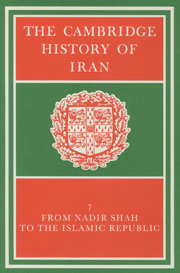Book contents
- Frontmatter
- PART 1 THE POLITICAL FRAMEWORK, 1722–1979
- PART 2 FOREIGN RELATIONS
- 8 IRANIAN RELATIONS WITH THE OTTOMAN EMPIRE IN THE EIGHTEENTH AND NINETEENTH CENTURIES
- 9 IRANIAN RELATIONS WITH RUSSIA AND THE SOVIET UNION, TO 1921
- 10 IRANIAN RELATIONS WITH THE EUROPEAN TRADING COMPANIES, TO 1798
- 11 IRANIAN RELATIONS WITH GREAT BRITAIN AND BRITISH INDIA, 1798–1921
- 12 IRANIAN FOREIGN POLICY, 1921–1979
- PART 3 ECONOMIC AND SOCIAL DEVELOPMENTS
- PART 4 RELIGIOUS AND CULTURAL LIFE, 1721–1979
- Genealogical tables
- Bibliographies
- Index
- References
8 - IRANIAN RELATIONS WITH THE OTTOMAN EMPIRE IN THE EIGHTEENTH AND NINETEENTH CENTURIES
from PART 2 - FOREIGN RELATIONS
Published online by Cambridge University Press: 28 March 2008
- Frontmatter
- PART 1 THE POLITICAL FRAMEWORK, 1722–1979
- PART 2 FOREIGN RELATIONS
- 8 IRANIAN RELATIONS WITH THE OTTOMAN EMPIRE IN THE EIGHTEENTH AND NINETEENTH CENTURIES
- 9 IRANIAN RELATIONS WITH RUSSIA AND THE SOVIET UNION, TO 1921
- 10 IRANIAN RELATIONS WITH THE EUROPEAN TRADING COMPANIES, TO 1798
- 11 IRANIAN RELATIONS WITH GREAT BRITAIN AND BRITISH INDIA, 1798–1921
- 12 IRANIAN FOREIGN POLICY, 1921–1979
- PART 3 ECONOMIC AND SOCIAL DEVELOPMENTS
- PART 4 RELIGIOUS AND CULTURAL LIFE, 1721–1979
- Genealogical tables
- Bibliographies
- Index
- References
Summary
The basis for the relationships between the Iranian and Ottoman empires in modern times was the Treaty of Qasr-i Shīrīn (17 May 1639). It ended the war which had gone on between the two for over a century and it established the boundaries which were to survive with little change into modern times. The salient division of the Middle East was preserved: the Tigris–Euphrates basin and eastern Anatolia remained under the Ottoman Sultan while the Caucasus remained in Iranian hands, later to fall to Russia. The Ottomans thus failed to achieve their long-standing objectives in the Caucasus and Āzarbāījān, but Mesopotamia and the route to the Persian Gulf were definitely restored to them, with the removal of the principal foreign stimulus to revolt in Anatolia, thus greatly simplifying the efforts of subsequent Ottoman reformers to revive the empire from within and so save it from foreign attack. During the next century the treaty was observed by both sides, but less out of genuine friendship than as a consequence of internal weakness, preoccupation with reform, and foreign aggression.
The spark for renewal of the conflict came, strangely enough, from these modern reforms introduced into the Ottoman Empire during the “Tulip Period” (1718–30) under the leadership of Sultan Ahmad III (1703–30) and his Grand Vizier, Damad Ibrahim Pasha. The financial burdens of modernization, when combined with popular hostility towards the European modes and frivolities then fashionable in the palaces of the Sultan and among members of the ruling class, so threatened the Establishment that the Grand Vizier was enticed into an attack on Iran, in the hope that advantage might be taken of the internal disintegration during the reign of the last Safavid, Shāh Sultān Husain (1694–1722), to replenish the Ottoman treasury and lessen the burden of taxation on the Sultan's subjects without diminishing the Sultan's pleasures.
- Type
- Chapter
- Information
- The Cambridge History of Iran , pp. 295 - 313Publisher: Cambridge University PressPrint publication year: 1991
References
- 1
- Cited by



